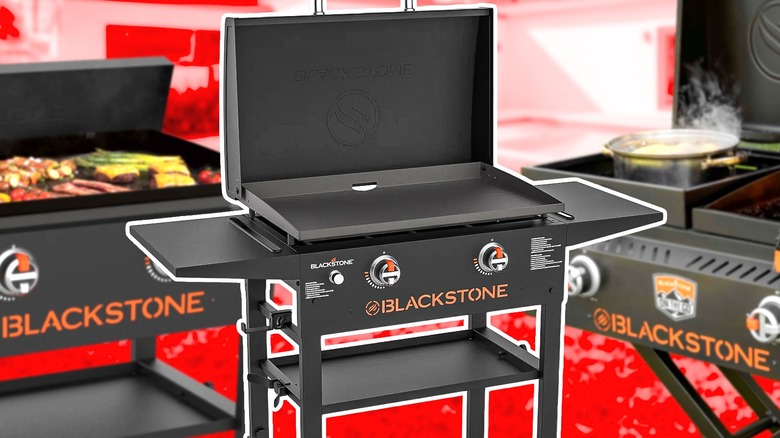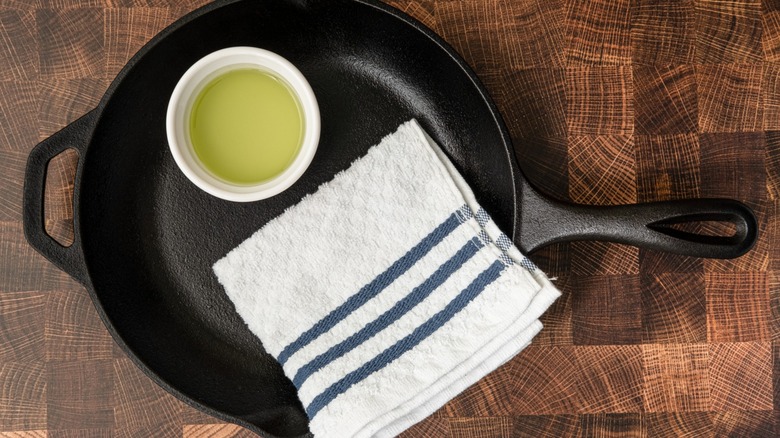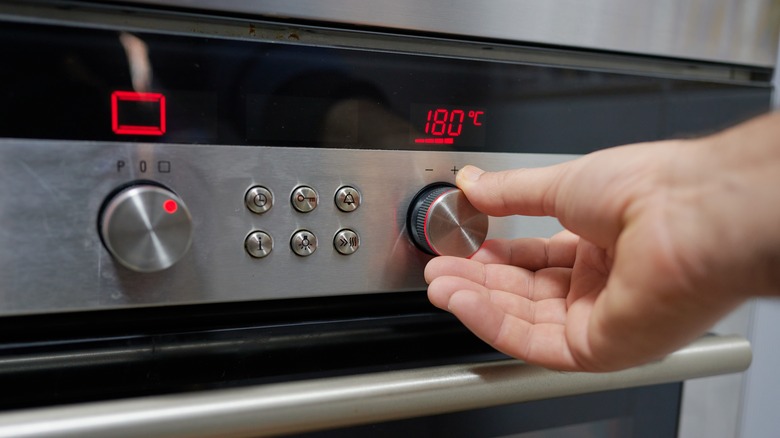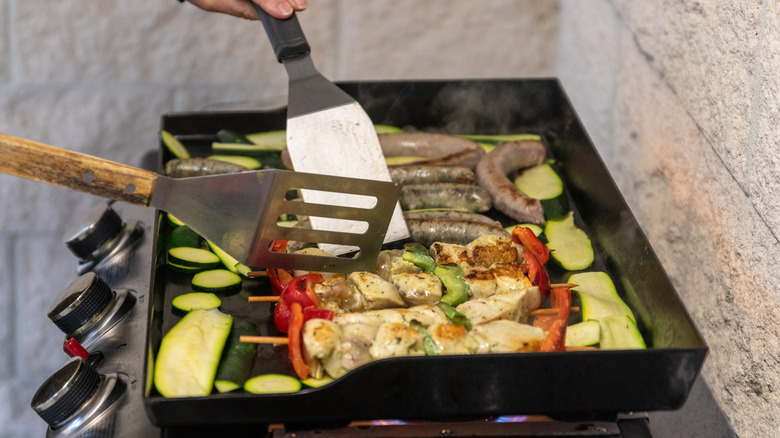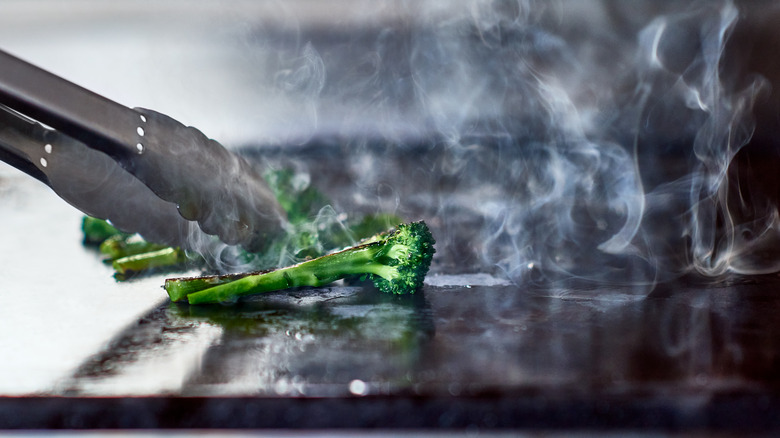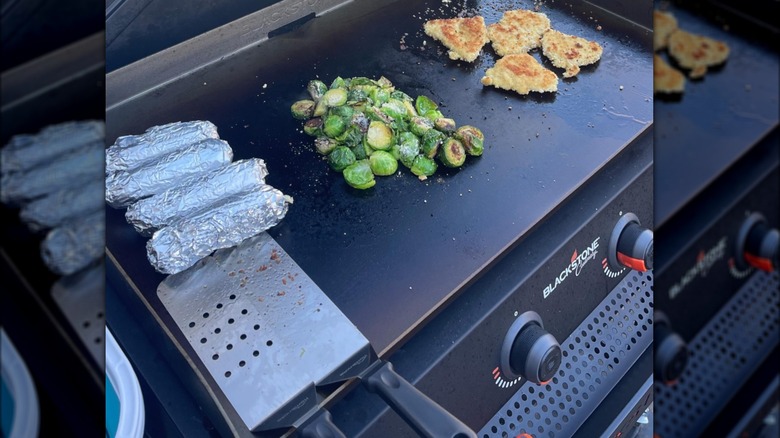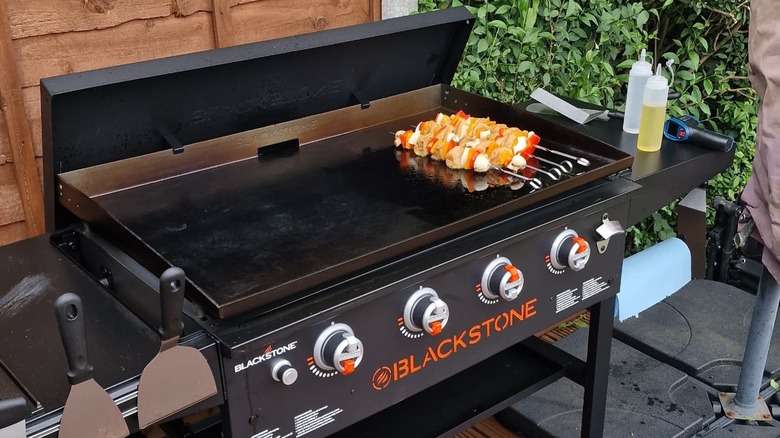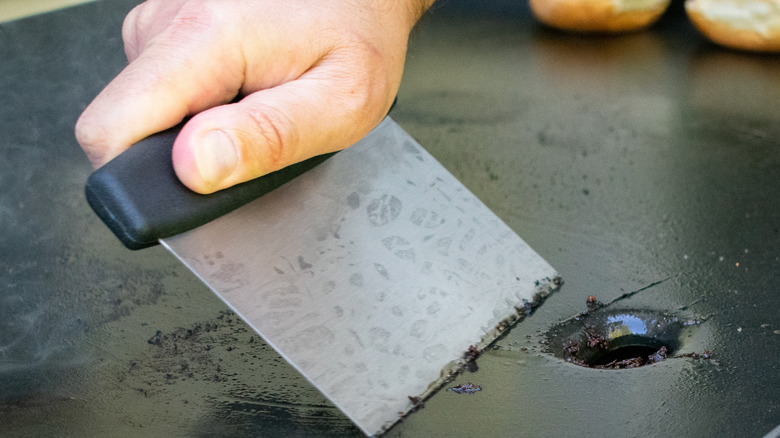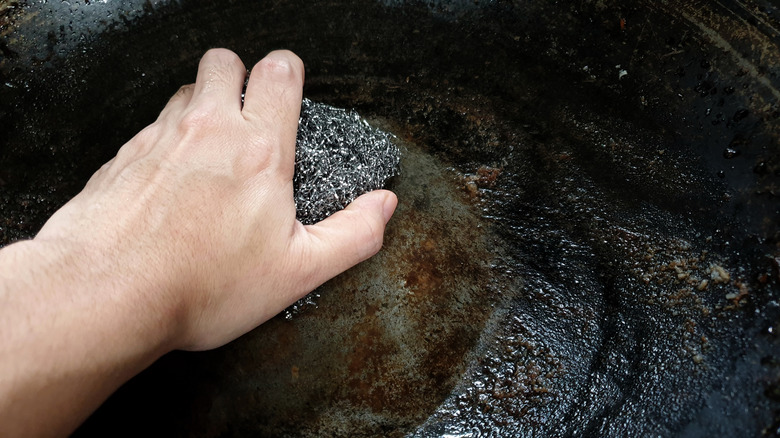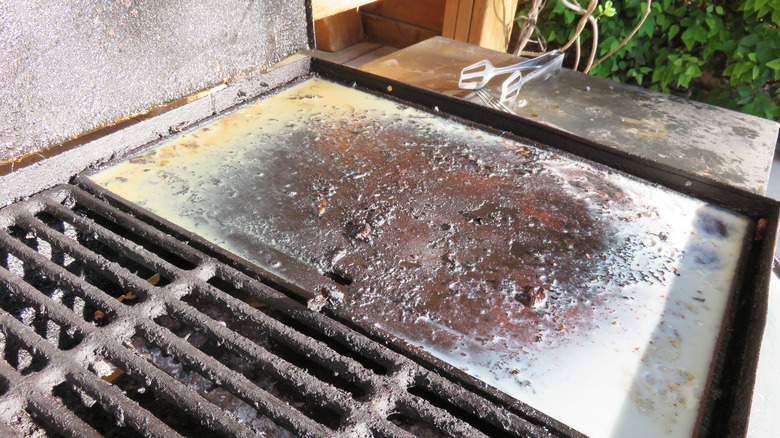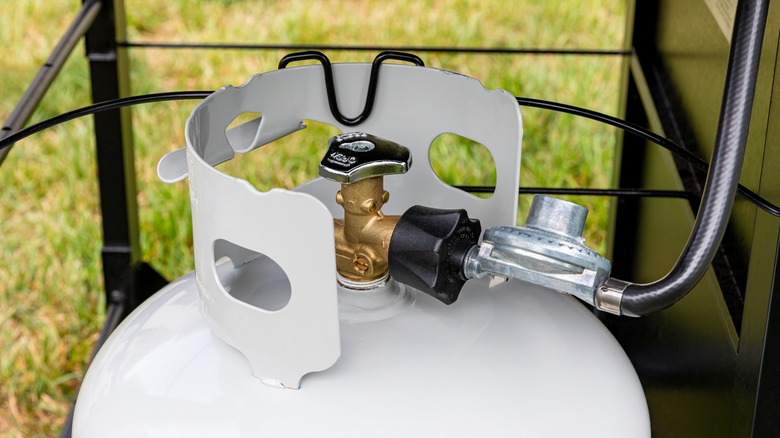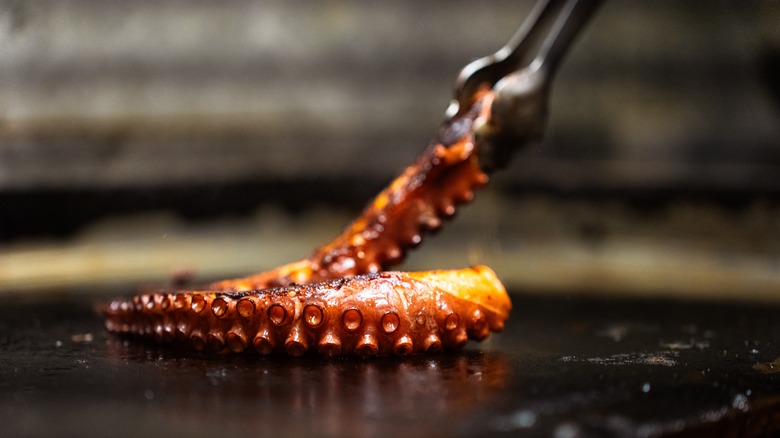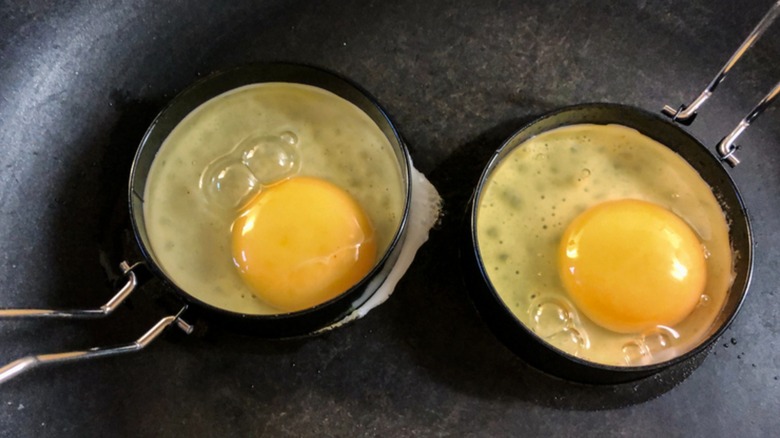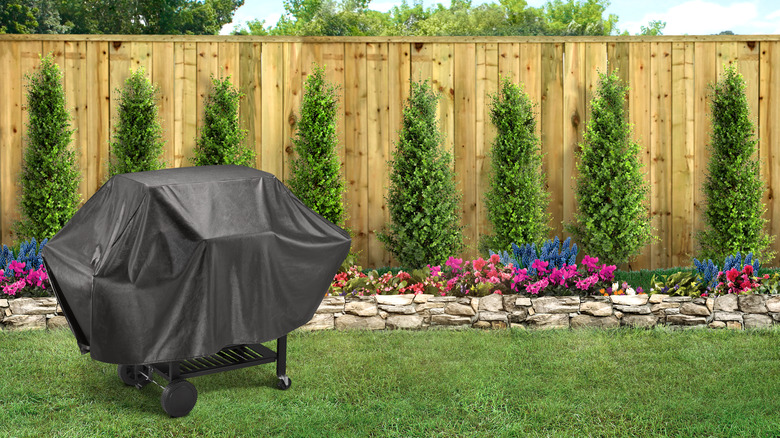13 Grilling Mistakes To Avoid According To Blackstone
As temperatures climb and tailgating season looms on the horizon, grilling continues to be the cooking method of choice for outdoor gatherings. There's just something about crowding around a smoky grill and watching the self-proclaimed grill master of the group labor over burgers, brats, steaks, and seasonal veggies as the savory smell of fire and meat fills the air. The only challenge with a traditional open-flame grill? Unless you want to bring extra cookware outside, you can really only cook whole meat and veg over the fire, leaving some members of your crew stranded in the kitchen on side-dish duty. That's where Blackstone comes in.
Makers of flat-top grills since 2008, Blackstone specializes in outdoor propane-powered griddles that allow you to cook just about anything on its smooth, flat surface. Made of cold-rolled steel, Blackstone griddles heat evenly and maintain temperature well, making them ideal for cooking just about anything under the sun, all without having to leave the comfort of your backyard.
As with any piece of culinary equipment, how you use a Blackstone griddle is just as important as what you cook on it. We went straight to the experts at Blackstone to find out the biggest mistakes people make with their Blackstone griddles and how best to avoid these pitfalls so you can whip up mouthwatering meals all year long.
Improper seasoning
Just like with your trusty cast iron skillet, Blackstone griddles require a little TLC to stay in tip-top shape. According to the experts at Blackstone, where most users fall short is in incorrectly seasoning their griddles — or worse, skipping the process altogether. By not seasoning your Blackstone griddle, you'll lose that glossy, nonstick surface and can inadvertently invite rust to the party.
To season your newly purchased griddle, simply wipe it down with a small amount of mild soap and hot water to remove any factory residue. Give it a good rinse with clean water, then turn the burners to high and let the surface dry out for around 10-15 minutes. Once the surface begins to turn brown, turn off the burners. From here, the process is similar to seasoning a cast iron skillet. Next, apply a super-thin layer of neutral oil with a high smoke point. Wipe down the griddle with a paper towel (hold the towel with tongs to avoid burning your hands) to remove any excess oil. The surface should look glossy and smooth, but there shouldn't be any pools of oil. Finally, turn those burners back on high. After about half an hour, the griddle will start to smoke, but don't panic — that's what you want. Once the smoke has dissipated, turn off the griddle and allow it to cool before repeating the process two or three times for maximum seasoned goodness.
Not preheating the griddle
The key to achieving perfectly seared steaks, beautifully browned pancakes, and fork-tender vegetables all comes down to an evenly heated cooking surface. We're talking about preheating — a step that the experts at Blackstone confirm is key. Just as you would with a cast iron skillet or conventional oven, preheating is an essential step for a Blackstone griddle, as is maintaining an even temperature.
While it depends on what temperature you're aiming for, it's always a good idea to give your grill roughly 5-10 minutes to heat up before attempting to cook on it. Using an infrared thermometer can confirm when the surface has reached the optimal cooking temperature. Is waiting around the most exciting part about cooking with your Blackstone griddle? No, but skipping this step can make all the difference between a wow-worthy meal and a massive disappointment — meats may not sear properly, and vegetables might turn out undercooked or overly tough. Your patience will be rewarded with a perfectly even cooking surface, ready to churn out a bountiful brunch spread or a gourmet grilled feast. Not only does preheating enhance the flavor and texture of your meals, but it also promotes efficient cooking and preserves the longevity of your griddle.
Overcrowding the cooking surface
As tempting as it is to use up every last inch of the cooktop when grilling with your Blackstone griddle, overcrowding is one cooking mistake you'll definitely want to avoid. Stuffing too many goodies onto the griddle may seem like an efficient use of space, but what you're actually doing is lowering the temperature of the cooktop and reducing your chances of achieving that oh-so-desirable golden brown crust.
When you add meats and vegetables to a hot surface, they begin to release moisture. If the cooking surface is hot enough, this moisture will evaporate and allow the surface to begin to brown. If the cooktop is overcrowded, the moisture won't evaporate fast enough, and your food will steam or stew instead of sear, leaving you with lackluster results. By leaving adequate space between ingredients, you ensure better heat distribution and more even cooking. This space allows the griddle to maintain its temperature, ensuring that each item has the opportunity to develop a delicious caramelized exterior while remaining tender and juicy inside.
For optimal results, practice moderation when loading up your Blackstone griddle. Give each ingredient enough room to breathe and cook properly, and you'll be rewarded with meals that are not only visually appealing but also bursting with flavor.
Leaving food stationary
A cardinal rule of grilling is to leave your meat alone in order to achieve a picture-perfect sear. However, when using your Blackstone griddle for other items like vegetables or pancakes, you'll want to use a different approach. According to Blackstone, in order to achieve the best griddle results, you'll want to keep your food moving around the cooktop. The reason for the shift lies in the nature of the cooking process itself.
Traditional grills and ovens rely on fluctuating heat sources that can create hot spots and areas of uneven heating. Flat griddles like the Blackstone provide consistent, even heat across the entire cooking surface. This uniform heat requires active management to ensure even cooking and avoid pitfalls such as uneven browning or burnt spots. When food remains stationary, it fails to take advantage of the griddle's consistent heat distribution. Moving your food around the cooktop also helps to prevent sticking by reducing the risk of burning or caramelization in any single spot.
Not using heat zones
Much like higher-end grills, some Blackstone griddles have multiple independently controlled heat zones that allow for the multitasking flexibility of a stovetop all on one flat surface. The obvious advantage of these heat zones, according to Blackstone, is the ability to cook a wide array of foods at their ideal temperatures. For example, you can have one section of the griddle set to high heat for searing meats while another section stays on a lower setting for gently warming tortillas or keeping other foods warm while the rest of your meal is cooking. This flexibility allows you to prepare an entire meal on a single griddle, optimizing both time and space while also minimizing post-dinner dishes.
Another benefit is improved control over the cooking process. By using different heat zones, you can manage how quickly and evenly your food cooks. This technique is particularly useful for dishes requiring multiple elements cooked at various temperatures, such as breakfast spreads where pancakes and eggs need different heat levels to cook perfectly. Most importantly, multiple heat zones help prevent overcrowding and sticking. Foods can be moved to cooler areas if they are cooking too quickly or if you need to make room for more deliciousness.
Unnecessary burner use
According to the experts at Blackstone, one of the most common mistakes grillers make with their Blackstone griddles is heating up the entire flat top when cooking just one or two items. Using the full griddle surface for smaller portions or single meals is often unnecessary and inefficient. Instead, you can easily take advantage of just one or two of the griddle's heat zones. This approach not only conserves fuel but also helps to preserve the seasoning that you've meticulously developed over time.
When you fire up all the burners, you're consuming more propane than needed, which leads to wasted fuel and a bigger dent in your wallet over time. All that excess heat can also affect the seasoning on the griddle surface, causing it to break down or degrade. This diminishes the griddle's all-important nonstick properties and requires you to re-season more frequently, costing you time in the long run.
By selectively using only the necessary heat zones, you maintain a more controlled cooking environment. This approach ensures even cooking and allows for better temperature management, preventing overheating and potential damage to your Blackstone griddle. As an added bonus, it also saves you time and effort on cleanup since you're only dealing with a portion of the surface area.
Neglecting grease management
As anyone who has ever worked with a flat-top griddle can attest, grease builds up fast. Left unchecked, this grease build-up can turn into a significant fire hazard and potentially cause lasting damage to your griddle surface. The high heat of the griddle exacerbates the situation, causing fat to splatter and accumulate rapidly, which can lead to dangerous flare-ups or even grease fires if not managed properly.
To maintain safety and keep your griddle in optimal working order, it's essential to regularly clean the flat top as you cook. Make it a habit to scrape excess grease and food debris into the rear grease cup of your Blackstone griddle. This simple step is crucial for several reasons. Firstly, it helps keep the cooking surface clean and free from excessive grease, which can otherwise lead to uneven cooking and unpleasant smoke. Secondly, timely removal of grease minimizes the risk of grease fires, helping you avoid the potential for dangerous mishaps that could result in a visit from the local fire department.
If you do find yourself on the business end of a grease fire, just remember to never try to put it out with water. The way to safely extinguish a grease fire is to turn off the heat source and smother it with a metal lid or pot. While it's unlikely that you'll need it, it's always a good idea to keep a fire extinguisher handy while grilling in case of emergencies.
Over-cleaning your griddle
While we've already addressed the importance of keeping your Blackstone griddle clean, over-cleaning your cooktop can be just as detrimental. According to the experts at Blackstone, excessive scrubbing and frequent cleaning can actually be harmful to your griddle's longevity and overall performance because it can strip away that vital seasoning layer that protects the griddle surface. Not only does this layer of oil baked into the metal cooktop provide a natural, nonstick surface, but it also helps to prevent rust. Overzealous cleaning, especially with harsh scrubbing pads or abrasive chemicals, can erode this protective layer, leaving the griddle susceptible to corrosion and affecting its cooking efficiency.
Aggressive cleaning can also disrupt the griddle's ability to retain and distribute heat evenly. Without the seasoning layer, the griddle can develop hot spots, leading to uneven cooking and potential food stickage; two factors that not only impact the quality of your meals but can also increase the time and effort required for cleaning. It's important to maintain a balanced approach to your griddle maintenance regimen. Use gentle methods to remove food residue and avoid excessive scrubbing. Regularly clean the surface of the griddle with a soft cloth or scraper, and ensure you properly re-season it after each use.
Under-cleaning your griddle
Maintaining that all-important layer of seasoning is paramount for optimal grill performance, but swing too far in the other direction, and you could end up with a greasy mess instead of a tidy Blackstone griddle. According to Blackstone, neglecting proper cleaning and storage can lead to significant issues. If you store your griddle without thoroughly cleaning and drying it, you risk creating a breeding ground for mold and attracting pests. Grease and food residue left on the surface can become a magnet for the stuff of backyard nightmares (unwanted insects and rodents), turning your griddle into a potential health hazard and an unattractive eyesore.
To prevent these problems, always make sure to clean your griddle after each use. Use gentle methods to remove food debris and wipe down the surface, then allow it to dry completely before storage. If your griddle does fall victim to mold or pest issues, a thorough deep-clean will be necessary to restore it to a safe and useable condition. Just remember to re-season the cooktop once it's back in working order.
Incorrect propane tank handling
Blackstone griddles draw their heating power from propane tanks, a seemingly benign piece of hardware that, if handled incorrectly, can lead to a whole host of issues. One of the primary risks of improper propane tank handling is inconsistent fuel supply. According to Blackstone, opening the propane valve too quickly or too far can trigger safety features that reduce flame intensity. When starting your griddle, open the valve slowly and only half a turn to avoid propane waste and performance issues.
If the tank is not securely connected or if there are leaks, the griddle could experience uneven heating, negating all of the benefits of cooking on a Blackstone griddle to begin with. Even worse, this issue can affect the griddle's performance over time and lead to uneven seasoning, making cooking less efficient and enjoyable. Mishandled propane tanks also pose significant safety hazards. Leaks or improper connections can lead to gas escapes, creating a fire risk. In severe cases, this could result in dangerous flare-ups or explosions. Regularly inspect the tank and connections for any signs of wear or leaks, and ensure that you handle and store the propane tank according to manufacturer guidelines.
Not experimenting
Blackstone griddles are ideally suited for burgers, steaks, and skewers, but one of the biggest mistakes you can make is not branching out beyond the basics. Thanks to their smooth, flat surface and even heating, griddles are super versatile, opening up a huge array of culinary possibilities beyond the usual cookout fare.
Once you've mastered cooking on a griddle-top grill, the world is your oyster. For instance, try grilling flatbreads like naan or pita for a delicious accompaniment to any meal. You can also venture into hibachi-style cooking by whipping up savory fried rice, complete with vegetables and teriyaki chicken cooked right on the griddle. You get even more creative by hacking fast food favorites like a homemade twist on a Crunchwrap.
But don't stop at savory dishes. Blackstone griddles are fantastic for making desserts, too. Grill peach halves to caramelize their natural sugars and serve with vanilla ice cream for a sweet summer treat. Whip up mess-free s'mores by melting the chocolate and marshmallow directly onto graham cracker halves. You can even elevate your brunch game by transforming pancakes into pineapple upside-down griddle cakes, adding a little extra tropical flair to your alfresco get-together.
Don't be afraid to accessorize
Gadgets aren't always the more efficient option in the kitchen, but with so much real estate available on your Blackstone griddle, there's no reason not to experiment with the wide world of flat-top accessories. With its large, versatile surface and multiple heat zones, a griddle offers a perfect opportunity to explore how these tools can enhance your cooking experience.
Once you've got the hang of utilizing those unique heat zones, incorporating griddle-top accessories can take your cooking to the next level. Whip up restaurant-quality breakfast sandwiches or brunchy burgers by employing an egg ring. Similar to a cookie cutter, this circular mold holds the egg in place so it cooks in an even circle and leaves less mess behind. In the same vein, food molds allow you to shape pancake batter, burgers, and other pliable mixtures into uniform, eye-catching forms. This not only elevates your dishes to professional status, but it also helps with portion control.
Basting domes are another great addition. These gadgets trap heat and moisture to accelerate cooking and ensure even results. They are especially useful for melting cheese or steaming vegetables, and they also help keep your griddle cleaner by containing splatters from fatty meats like bacon or pork belly.
Don't neglect maintenance
Don't underestimate the importance of performing regular maintenance measures on your Blackstone griddle. Neglecting to properly care for your griddle during long periods of non-use can lead to major issues that affect both performance and longevity. According to the experts at Blackstone, one major concern is that extended periods between uses can cause the seasoning on the griddle plate to dry out and deteriorate. This dried-out surface can lead to a tough, sticky mess that is challenging to clean and may require more extensive maintenance to restore.
To ensure that your griddle remains in top condition, the team at Blackstone says that it's essential to prepare it properly before storing it away. Start by thoroughly cleaning the griddle, removing all food debris and grease, then dry the surface completely to prevent moisture from causing rust or other damage. Next, apply a thin layer of oil to maintain the seasoning. This layer helps to protect the griddle surface and keeps up its nonstick veneer.
When not in use, be sure to cover your Blackstone griddle with a hood or protective cover and store it in a cool, dry place. This simple step shields the griddle from dust, debris, and environmental factors that can degrade both the seasoned cooktop and the metal outer shell. By committing to these maintenance practices, you can ensure that your griddle remains in excellent working condition, ready for your next backyard culinary adventure.
